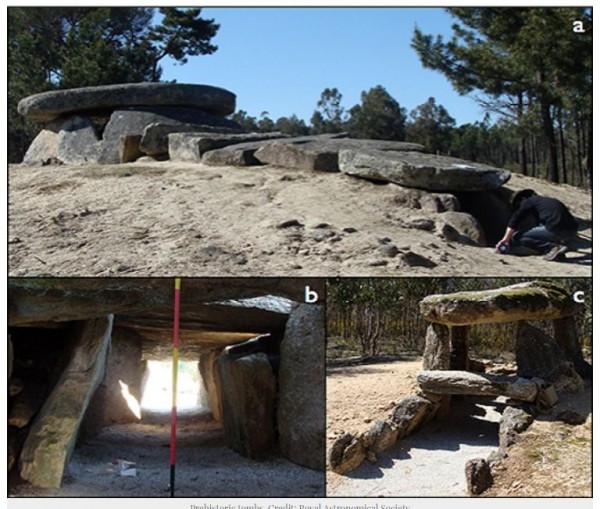Prehistoric Stone Tombs might have been the First Telescopes
| Arthur Dominic Villasanta | | Jul 04, 2016 11:40 PM EDT |
(Photo : Royal Astronomical Society) Prehistoric tombs that might have been used as ancient observatories
Massive European megalithic tombs some 6,000 years-old were probably the first astronomical observing tools or telescopes used by prehistoric humans.
British astronomers contend the extended narrow entrances in igloo-shaped structures known as "passage graves" made of rock enhanced the night sky. These entrance chambers might have magnified a viewer's night vision, allowing him to detect stars rising at twilight sooner than he would otherwise have been able to.
Like Us on Facebook
The team that pretended a study of these passage graves at the recent National Astronomy Meeting argue the prehistoric tombs might have been sacred and were used as rites of passage where the initiated would spend the night.
The only light inside these tombs came from the night sky shining down the entrance on which were placed their ancestors' remains. Ancient humans might have believed this lighting caused their ancestors to give them special powers.
"The orientations of the tombs may be in alignment with Aldebaran, the brightest star in the constellation of Taurus," said Fabio Silva, the research team leader. "To accurately time the first appearance of this star in the season, it is vital to be able to detect stars during twilight."
Kieran Simcox, who is also part of the team, said that by using these passage graves, "the observer would have sat in complete darkness, with only the opening to the passage grave in front of them showing the part of the sky where the star rises."
"By reducing the background area and focusing on just a small part of the sky, an observer will be able to see a star earlier than had they been outside," said Simcox.
Passage graves consisted of tombs placed in single or multiple chambers with a corridor leading to an entrance. The tomb was covered with mounds of earth or stone.
According to the research team, most passage graves date back to the Neolithic period between 6,000 and 2,000 B.C. Famous examples of passage graves are found in Newgrange in Ireland and Maeshowe in Scotland. There are also similar tombs in Spain and Scandinavia.
"They were clearly a widespread phenomena spanning the entire Atlantic coast. Different regions had their own traditions and architectural styles, but they are all variations on a theme," said the study.
The research team consisted of Daniel Brown from Nottingham Trent University, Fabio Silva of the University of Wales Trinity Saint David, and Kieran Simcox from Nottingham Trent University.
©2015 Chinatopix All rights reserved. Do not reproduce without permission
EDITOR'S PICKS
-

Did the Trump administration just announce plans for a trade war with ‘hostile’ China and Russia?
-

US Senate passes Taiwan travel bill slammed by China
-

As Yan Sihong’s family grieves, here are other Chinese students who went missing abroad. Some have never been found
-

Beijing blasts Western critics who ‘smear China’ with the term sharp power
-

China Envoy Seeks to Defuse Tensions With U.S. as a Trade War Brews
-

Singapore's Deputy PM Provides Bitcoin Vote of Confidence Amid China's Blanket Bans
-

China warns investors over risks in overseas virtual currency trading
-

Chinese government most trustworthy: survey
-

Kashima Antlers On Course For Back-To-Back Titles
MOST POPULAR
LATEST NEWS
Zhou Yongkang: China's Former Security Chief Sentenced to Life in Prison

China's former Chief of the Ministry of Public Security, Zhou Yongkang, has been given a life sentence after he was found guilty of abusing his office, bribery and deliberately ... Full Article
TRENDING STORY

China Pork Prices Expected to Stabilize As The Supplies Recover

Elephone P9000 Smartphone is now on Sale on Amazon India

There's a Big Chance Cliffhangers Won't Still Be Resolved When Grey's Anatomy Season 13 Returns

Supreme Court Ruled on Samsung vs Apple Dispute for Patent Infringement

Microsoft Surface Pro 5 Rumors and Release Date: What is the Latest?













